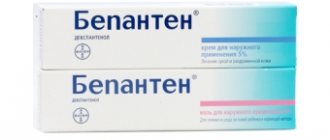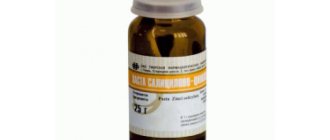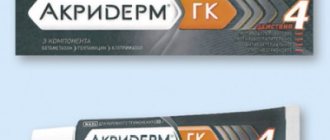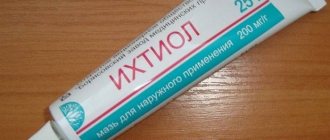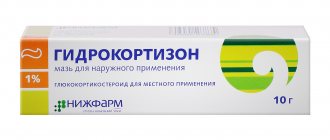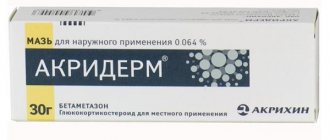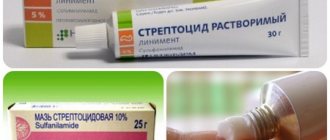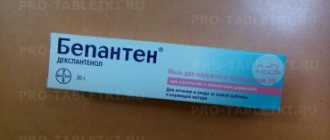We try to get rid of acne in many ways and use a wide variety of means, naively expecting at least some result. Many girls even use very dangerous drugs that are not intended for the skin. An excellent example is boric acid, the effect of which on skin we described in detail in this article . Among the products that were not originally intended for the treatment of acne include sulfur. In this article we will talk about whether sulfur ointment can help against acne, what properties it has and how to use it if you decide to use it.
We will try to be as objective as possible - we will study the composition of the product and the properties of the components from which it consists. And then, we’ll correlate this with the mechanism of acne and draw a conclusion about whether sulfur can stop this process.
Composition and release form
The drug is a thick ointment with a pronounced fatty consistency. It has a rich yellow color and a specific sulfuric odor. The medicine is sold in aluminum tubes or glass bottles with a sealing cap. The product is packaged in a cardboard box, which also contains instructions for use. Sulfur ointment for acne on the face contains the following components:
- The active substance is natural mineral sulfur. Its concentration in the drug can be 8, 10 or 33%.
- Ointment base. Usually it is simple medical Vaseline, but some manufacturers make medicine based on paraffin and mineral oils.
- Emulsifier. An auxiliary substance that ensures sufficient contact of sulfur with the upper layers of the epidermis. If it is excluded from the composition, then most of the sulfur will not be able to have a healing effect on the skin.
- Distilled water.
The proportions of water, petroleum jelly and emulsifier in the emulsion differ among different manufacturers. Any additional components are added to the composition extremely rarely.
Sulfur-salicylic ointment
The composition of the ointment with salicylic contains significantly less sulfur than simple sulfur ointment. It contains only 2g 100g base (2%). In addition to sulfur, the ointment also contains 2 g of salicylic acid. It significantly enhances the antibacterial and antiseptic effect. It also regulates the secretion of sebum, which provides a drying effect.
In addition, salicylic acid penetrates deeply into the skin and causes increased blood circulation. What accelerates tissue regeneration.
Sulfur-salicylic ointment cleanses pores and dries out inflammation. However, the composition with salicylic acid is irritating. Therefore, it is used for oily skin and not for dry skin. For dry skin, a simple one-component ointment with sulfur is better suited.
Salicylic acid is often used to treat acne. It can cause a burn (if applied as a compress) or dry out the skin too much (if you frequently wipe your face with acid or alcohol). Therefore, they began to use salicyl in a complex manner, adding it to preparations along with other components.
The list of diseases for which sulfur-salicylic ointment is used includes juvenile acne, ringworm, mites under the skin and demodicosis.
Now let’s look at what sulfur ointment helps people with.
Operating principle
The drug belongs to the pharmacological group of antiseptics and disinfectants. Its active ingredient is sulfur. Once on the epidermis, this natural mineral reacts with organic compounds of the skin. As a result of the processes that take place, it breaks down into metabolites - sulfites and pantothenic acid, also known as vitamin B5. It is these derivatives that determine the beneficial properties of sulfur ointment for acne.
The drug helps in the fight against acne on both the face and body. The drug can be used regardless of the size and location of the lesions. In addition to acne, it shows itself well in the treatment of bacterial and fungal skin infections, as well as parasitic infestations. The following properties help him in this:
- The ability to suppress the vital activity of various microorganisms. Sulfur destroys bacteria and fungi, and also prevents their reproduction and spread. The drug has a similar effect on subcutaneous mites. Thus, the medicine not only eliminates pimples and blackheads, but also fights the cause of their occurrence.
- Anti-inflammatory and disinfecting effect. The active substance of the drug quickly stops inflammatory processes, prevents the spread of infection and has a softening effect. This effect helps eliminate redness on the skin, reduce swelling, prevent relapses and reduce the likelihood of scarring.
- Improving microcirculation. An ointment with a high concentration of sulfur slightly irritates the skin, which leads to the expansion of capillaries and improved blood supply to skin cells. This helps restore a healthy complexion to the face and reduces the rate of cell death.
- Exfoliating effect. The drug promotes the separation of dead skin cells, which helps fight scars, as well as blue and red spots.
- Impact on pores. Sulfur normalizes the production of secretions by the sebaceous glands, which is why they stop getting clogged and the skin loses its oily shine. In addition, the mineral removes purulent exudate from the pores and prevents its formation.
- Acceleration of metabolic and regenerative processes. Exposure to sulfur ointment accelerates metabolic processes in skin cells - they begin to receive more nutrients and absorb them better. In addition, the use of the drug promotes the healing of scratches and wounds on the face, and also prevents their infection.
In addition to its therapeutic effects, sulfur ointment also has the ability to even out complexion, reduce and heal scars. It is often used to treat post-acne and eliminate the consequences of squeezing pimples.
Indications for use
Sulfur ointment is a universal drug that is used to combat various skin lesions. Most often it is used in the treatment of such diseases and conditions:
- severe forms of acne, accompanied by enlarged pores, swelling, subcutaneous pimples, darkening and other complications;
- demodicosis, scabies and other skin diseases caused by parasites;
- psoriasis, accompanied by the appearance of papules and plaques on the skin, causing pain to the patient;
- dermatitis, except allergic;
- blackheads, pimples, blackheads and other rashes;
- lichens of bacterial and viral origin;
- dandruff;
- seborrheic skin lesions and other diseases arising from disturbances in the functioning of the sebaceous glands;
- mycoses - fungal diseases;
- post-acne, scars and scars left after acne removal;
- other skin diseases caused by pathogenic microorganisms.
Sulfur-based ointment is never used to treat irritations and rashes caused by allergic reactions. It is also ineffective in combating redness on the skin, the cause of which is damage to blood vessels or malfunctions of the circulatory system.
Sulfur ointment for lichen
Usually the word lichen refers to fungal infections of the skin. This infectious disease in medical terminology is called microsporia or trichophytosis, and in the generally accepted version - ringworm. To treat it, you can use an inexpensive salicylic-sulfur composition. However, there are other, more effective means.
The sulfur composition has remained popular in the treatment of lichen in animals. Thus, veterinarians recommend using sulfur ointment for cats with large areas affected by lichen, if it is necessary to treat the entire body. It is also recommended to supplement treatment with internal antifungal medication.
Ringworm is an inflammation of the skin caused by a fungus or infection. It is transmitted through contact with an infected person or animal. The inflamed area has a red or brown tint. The skin on the plaque peels severely and pulsates.
Sulfur ointment allows you to get rid of the symptoms of the disease and eliminate foci of inflammation. However, for effective treatment you need to take medications orally.
Use sulfur ointment to treat lichen as follows:
- Treat inflamed areas with salicylic alcohol.
- Apply ointment carefully.
- Leave the ointment on overnight.
- In the morning, take a warm shower, carefully rinsing off the product (you can use soap).
You need to repeat the procedure every evening for 2 days. On the 3rd day you need to take a break and then continue using it again. The course of treatment for lichen with ointment is 7 days (the maximum course of use is 10 days).
Advantages and disadvantages
Like any other medication, sulfur paste for acne has both pros and cons. The benefits of this medicine include:
- Low price. The drug can be bought at any pharmacy for only 20-60 rubles, which is much cheaper than many other dermatological products. The medicine is available without a prescription and is stored for 2 years.
- All-round impact. The product helps both in the direct treatment of acne and in preventing their reappearance. The ointment is equally effective in the fight against bacterial, viral and parasitic skin lesions.
- Minimum contraindications and side effects. The drug is made on the basis of a natural mineral, therefore, when used correctly, serious undesirable consequences are rarely observed.
- Neutralizing the cause of acne. Sulfur not only eliminates acne, but also kills microorganisms that provoke their appearance.
Unfortunately, sulfur ointment against acne also has significant disadvantages, due to which this drug is not suitable for everyone. Among its disadvantages are the following properties:
- Unpleasant procedure. Sulfur paste is a very greasy product that needs to be left on the skin for a long time, which not everyone will like. In addition, if applied carelessly, you can leave persistent greasy stains on clothes that cannot be washed off.
- Specific smell. Sulfur has a very strong unpleasant odor that is difficult to remove. Considering that the ointment will have to be applied to the face, many consider its smell to be a sufficient argument to give preference to another medicine.
- Overdrying of the skin. Many patients report a feeling of dryness and tightness of the skin after using sulfur ointment. Lotions and nourishing creams help combat this effect.
To buy or not
Our analysis and customer reviews have shown that sulfur ointment is an excellent remedy for acne, which will be useful to any person and will be affordable for everyone. It is necessary to have it at home, even if your skin is completely healthy, because suppuration can appear at any time.
Also, in addition to acne, this drug will help you get rid of many other diseases of the epidermis: calluses, psoriasis, lichen, demodicosis and even scabies. So get off the couch right now and quickly go to the pharmacy to buy this “magic remedy”!
Instructions for use
Sulfur ointment is a preparation for external use only. When using it, you must adhere to the following rules:
- Before using the drug, it is necessary to prepare the skin. You need to remove the remnants of decorative and medicinal cosmetics from it, then wash and thoroughly dry your face with a towel.
- The product should be distributed with light massage movements, rubbing into problem areas. Apply a thin layer of ointment to small rashes and blackheads, and a thick layer to large pimples and blackheads. Healthy areas of the skin are not affected.
- The peculiarity of sulfur-based ointment is that it is difficult to wash off with plain water. For this purpose, it is best to use vegetable oil heated in a water bath. They need to moisten a cotton pad, which removes any remaining drug. After completing the procedure, you need to wash and dry your face well, and then apply a nourishing cream to it.
- The length of time the ointment is left on the face depends on the skin type, diagnosis and the amount of active ingredient in the preparation. To remove acne and blackheads, it is enough to leave the product for 20-30 minutes, but when treating subcutaneous acne and scars, the duration of the procedure can increase to 3-5 hours or more.
- The ointment should be applied to the face once a day. Its effectiveness does not depend on the time of day or food intake, but for convenience, the product is most often applied before bed. The recommended duration of one course is 7-10 days; if necessary, it can be extended for another week.
- It is not recommended to use the ointment in combination with compresses and tight bandages, as this can lead to allergic reactions and skin irritation.
- You can combine the medicine with other external agents to treat acne, but you should avoid applying several drugs to the skin at the same time. You should also not use sulfur-based ointment together with other medications containing this mineral, as there is a high risk of an overdose.
The use of this drug has its own nuances. To eliminate small pimples and acne on the top layer of skin, only ten percent ointment should be used. It is applied in a very thin layer. During the course of treatment, you must adhere to a diet that excludes sweet and starchy foods, as well as alcoholic beverages.
The ointment is effective against lichen only in the initial stages of its development. Before applying the drug, the skin is treated with salicylic alcohol - this increases the effectiveness of sulfur.
To eliminate spots and scars after acne, an ointment containing 10% active substance is also used. It is applied in a very thin layer twice a day, rubbing into the problem area. The course of treatment can be continued until the defects disappear.
Sulfur pigweed for demodicosis (skin mite infestation) is also used twice a day. It is used as an application and left for 3 hours.
If you have psoriasis, the patient should definitely discuss the possibility of using the ointment with the doctor. The drug dries the skin, which is undesirable for this disease.
When using acne products, you must carefully follow the instructions. It is highly advisable to consult a dermatologist before treatment and establish an accurate diagnosis.
Side effects and contraindications
Despite its natural composition, the drug has contraindications that must be taken into account before starting its use. These include:
- age under 14 years;
- pregnancy;
- lactation;
- open wounds and cuts on the skin of the face;
- allergy to the components of the drug.
The only side effects noted are allergic reactions on the skin. They manifest themselves as redness and burning in the area of application. To avoid their occurrence, you need to test the product by applying a thin layer of it to the skin of the inside of your wrist. If redness, itching, local fever and other signs of allergy are observed in this area, you should stop using the drug. The affected area should be rinsed with cold water and treated with a restorative lotion, after rinsing off any remaining product with a cotton pad soaked in vegetable oil.
How to treat formations caused by subcutaneous mites?
So, if your acne is caused by skin mites, sulfur will be a godsend for you. The course of treatment in this case is designed for only 5–7 days, however, to achieve the desired result, a number of conditions must be met:
- Apply the product in a thin layer (do not try to use too much sulfur, it can cause dry skin).
- You don’t wash off the composition; every day you apply a new layer on top of the previous one.
This technique received positive reviews from people who decided to resort to it. According to some statements, the use of the product gave positive results already on the 2nd day after the start of treatment.
